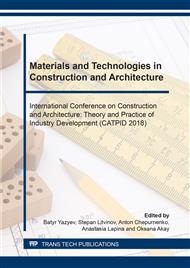[1]
D. V. Oreshkin, Environmental problems of integrated development of mineral resources in the large-scale utilization of man-made mineral resources and waste in the production of building materials, Stroitel'nye materialy. 8 (2017) 55 – 63.
Google Scholar
[2]
Hanizam Awang, Muhammad Hafiz Ahmad, the Durability Properties of Foamed Concrete with Fiber Inclusion, International Journal of Civil, Environmental, Structural, Construction and Architectural Engineering, World Academy of Science, Engineering and Technology. 3 (2014).
Google Scholar
[3]
G. S. Slavcheva, E. M. Chernyshev, Algorithm of construction of the structure of cement foam concrete on the set of properties, Stroitel'nye materialy. 9 (2016) 58 - 64.
Google Scholar
[4]
Md Azree Othuman Mydin, Sara Soleimanzadeh, Effect of Polypropylene Fiber Content on Flexural Strength of Lightweight Foamed Concrete at Ambient and Elevated Temperatures. Advances in Applied Science Research Journal, Pelagia Research Library, 3 (2012).
Google Scholar
[5]
G. S. Slavcheva, E. M. Chernyshev and M. V. Novikov. Heat-efficient foam concrete of new generation for low-rise construction, Stroitel'nye materialy. 7 (2017) 20-24.
Google Scholar
[6]
G. Yakovlev, J. Keriene, A. Gailius and I. Girniene, Cement based foam concrete reinforced by carbon nanotubes, Materials Science. 2 (2006) 147-151.
Google Scholar
[7]
Yu.A. Tabunshchikov, World view on building energy and energy saving, Energosberezhenie. 3 (2008) 68.
Google Scholar
[8]
O. A. Korol, Research and knowledge development in the field of energy-efficient building production, Stroitel'nye materialy. 6 (2015) 13 – 15.
Google Scholar
[9]
N. Karpenko, V. N. Ermakovskiy The main directions of resource efficiency in the construction and operation of buildings. Part 1. Resource efficiency at the manufacturing stage of construction materials, building products and filler structure, Stroitel'nye materialy. 7 (2013).
Google Scholar
[10]
L. V. Morgun, V. N. Morgun, A. Yu. Bogatina and A.V. Visnap, About the properties of materials that comply with the requirements of the panel construction, Stroitel'nye materialy. 10 (2016) 24-26.
Google Scholar
[11]
L.V. Morgun, Engineering solution to the problem of improving the operational reliability of foam concrete, in: Concrete and reinforced concrete - glance at future: proceedings of I all-Russian (II International) conference on concrete and reinforced concrete. Moscow, 2014, 309-314.
DOI: 10.1201/b12978-8
Google Scholar
[12]
A.D. Zhukov, A.V. Chugunkov and P.K. Gudkov, Geometric model of cellular concrete and prediction of its properties, Scientific and practical online magazine Nauka. Stroitel'stvo. Obrazovanie,. 2 (2012) Information on: http://www.nso-journal.ru.
Google Scholar
[13]
Md Azree Othuman Mydin, Muhammad Hafiz Ahmad and Hanizam Awang, Mechanical and Durability Properties of Fibre Lightweight Foamed Concrete, Australian Journal of Basic and Applied Sciences. 7 (2013) 14-21.
DOI: 10.37934/arfmts.86.1.123139
Google Scholar
[14]
K.I. Kostylenko, L.V. Morgun, P.V. Smirnova, O.V. Pushenko and V.N. Morgun, On the influence of temperature on the formation of the structure of foam concrete mixtures, Inzhenernyy Vestnik Dona. 1 (2012) 526-529.
Google Scholar
[15]
L.V. Morgun, K.I. Kostylenko and V.N. Morgun, Features of transformation of structures of dispersed gas phase at production of foam concrete mixes, Construction-2014, Rostov-on-Don, 2014, pp.75-77.
Google Scholar
[16]
L.V. Morgun, O.Yu. Shcheglova, Influence of the form of dispersed particles of raw components of concrete mixtures on the requirements for the concrete mixer activator, Izvestiya RGSU. 18 (2014) 42-46.
Google Scholar
[17]
L.V. Morgun, V.N. Morgun, V.A. Visnap and I. A. Cherenkova, The possible types of structures of the dispersed gas phase in the manufacture of foam concrete mix, Young scientists in solving actual problems of science, Vladikavkaz, 2015, 80-82.
Google Scholar
[18]
V.N. Morgun, L.V. Morgun, A.J. Bogatina and A.A. Revyakin, The contribution of fibers in the operational reliability of concrete, Defects of buildings and structures, strengthening of building structures, Saint-Petersburg, 2017, 257-281.
Google Scholar
[19]
L. K. Neudachina, Yu. S. Petrov, Application of surfactants in the analysis. Publishing house of Ural state University, Ekaterinburg, (2017).
Google Scholar


